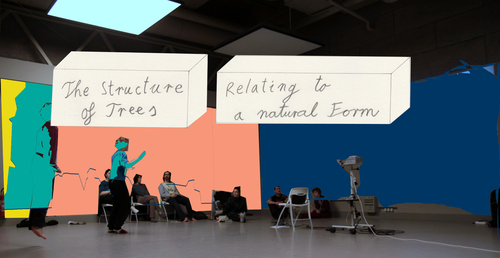09 / 06 / 2017
EXHIBITION
BADco. & Marko Tadić "Dispositives of Watching" @ Vladimir Bužančić Gallery, 12.-29.06.2017

exhibition opening: 12.06.2017 at 20:00
exhibition is open until 29.06.2017
Vladimir Bužančić Gallery (Culture Centre Novi Zagreb, Remetinec)
The exhibition Dispositives of Watching is a part of the year-long collaboration between BADco. and Marko Tadić titled Nothing Inert in the World, including artistic research, an exhibition and performative events thematizing rhythmanalysis, the principles of complex rythmical (spatial-temporal) structures.
This exhibition has been developed in situ at the Gallery Vladimir Bužančić in Remetinec and are but a step in the process that will result in the theatre production Corrections in Rhythm that premieres in November 2017 at the Croatian National Theatre in Zagreb.
The exhibition includes text by Goran Ferčec.
It is a mistake to think that the painter works on a white surface. The figurative belief follows from this mistake. If the painter were before a white surface, he could reproduce on it an external object functioning as a model, but such is not the case. The painter has many things in his head, or around him, in his studio. Now everything he has in his head or around him is already in the canvas, more or less virtually, more or less actually, before he begins his work. They are all present in the canvas as so many images, actual or virtual, so that the painter does not have to cover a blank surface but rather would have to empty it out, clear it, clean it.
Gilles Deleuze: Francis Bacon: The Logic of Sensation
Theatre is often understood as an art that shows itself to the viewer, and all attempts at changing this image of theatre have been an attempt at changing the viewer’s function, whereby the viewer has always been understood as someone external to theatre. However, the manifestation of theatre has rarely been discussed: namely, that theatre always already includes the viewers and their viewing, even during the rehearsals, when the viewing is merely supposed and theatre happens before the unborn spectator.
The event of theatre, unlike its show, has rather refractive then reflective character. And that refraction occurs precisely on the membrane that separates its two different local manifestations, whereby the style of existence of its participants changes as well: it is theatre as the institutional relationship between the audience (public) and the artists (producers), and theatre as a poetic set or conjuncture of viewers and actors in performance (living and non-living). However, I am not referring to refraction as an effect of one idea passing through two different media or two ideologies. It is more adequate to think of it as a deflection in the style of existence of theatre’s agents (the viewers and the artists), resulting from an encounter on the membrane between the institution and poetics. In this duality, theatre realizes its power of refraction: it is now materially factual and thus the world does not see itself only in theatre, but also through theatre, which makes theatre a polygon par excellence for reflecting on social objects, its parallel involvement in social processes, as well as the ways of separating from them. Theatre always resembles other social processes and differs from them at the same time; nevertheless, it is becoming increasingly difficult to maintain this dual status, owing to the transformations in the modes of production.
If we attempt to approach theatre from the perspective of Deleuze’s understanding of the painter’s process, not as an empty space but as infrastructure of watching, then it is a space already overwhelmed and prestressed by different dispositives of watching and showing. We addressed the space of the Gallery Vladimir Bužančić with Marko Tadić as an ideal space for theatrical work, as an atelier, a dance studio, an auditorium, a white box, a film studio, a forensic laboratory, an archive... And all at once. It is a space that does not have to be filled but cleansed to be able to accommodate production, rehearsing, exhibiting, disassembling, folding, archiving, watching... It is a space featuring all the perspectives of our previous and future performances, where the staging happens by dragging out and decluttering our compressed storage.
09 / 06 / 2017
EXHIBITION
BADco. & Marko Tadić "Dispozitivi gledanja" @ Galerija Vladimir Bužančić, 12.-29.06.2017.

exhibition opening: 12.06.2017 at 20:00
exhibition is open until 29.06.2017
Vladimir Bužančić Gallery (Culture Centre Novi Zagreb, Remetinec)
The exhibition Dispositives of Watching is a part of the year-long collaboration between BADco. and Marko Tadić titled Nothing Inert in the World, including artistic research, an exhibition and performative events thematizing rhythmanalysis, the principles of complex rythmical (spatial-temporal) structures.
This exhibition has been developed in situ at the Gallery Vladimir Bužančić in Remetinec and are but a step in the process that will result in the theatre production Corrections in Rhythm that premieres in November 2017 at the Croatian National Theatre in Zagreb.
The exhibition includes text by Goran Ferčec.
It is a mistake to think that the painter works on a white surface. The figurative belief follows from this mistake. If the painter were before a white surface, he could reproduce on it an external object functioning as a model, but such is not the case. The painter has many things in his head, or around him, in his studio. Now everything he has in his head or around him is already in the canvas, more or less virtually, more or less actually, before he begins his work. They are all present in the canvas as so many images, actual or virtual, so that the painter does not have to cover a blank surface but rather would have to empty it out, clear it, clean it.
Gilles Deleuze: Francis Bacon: The Logic of Sensation
Theatre is often understood as an art that shows itself to the viewer, and all attempts at changing this image of theatre have been an attempt at changing the viewer’s function, whereby the viewer has always been understood as someone external to theatre. However, the manifestation of theatre has rarely been discussed: namely, that theatre always already includes the viewers and their viewing, even during the rehearsals, when the viewing is merely supposed and theatre happens before the unborn spectator.
The event of theatre, unlike its show, has rather refractive then reflective character. And that refraction occurs precisely on the membrane that separates its two different local manifestations, whereby the style of existence of its participants changes as well: it is theatre as the institutional relationship between the audience (public) and the artists (producers), and theatre as a poetic set or conjuncture of viewers and actors in performance (living and non-living). However, I am not referring to refraction as an effect of one idea passing through two different media or two ideologies. It is more adequate to think of it as a deflection in the style of existence of theatre’s agents (the viewers and the artists), resulting from an encounter on the membrane between the institution and poetics. In this duality, theatre realizes its power of refraction: it is now materially factual and thus the world does not see itself only in theatre, but also through theatre, which makes theatre a polygon par excellence for reflecting on social objects, its parallel involvement in social processes, as well as the ways of separating from them. Theatre always resembles other social processes and differs from them at the same time; nevertheless, it is becoming increasingly difficult to maintain this dual status, owing to the transformations in the modes of production.
If we attempt to approach theatre from the perspective of Deleuze’s understanding of the painter’s process, not as an empty space but as infrastructure of watching, then it is a space already overwhelmed and prestressed by different dispositives of watching and showing. We addressed the space of the Gallery Vladimir Bužančić with Marko Tadić as an ideal space for theatrical work, as an atelier, a dance studio, an auditorium, a white box, a film studio, a forensic laboratory, an archive... And all at once. It is a space that does not have to be filled but cleansed to be able to accommodate production, rehearsing, exhibiting, disassembling, folding, archiving, watching... It is a space featuring all the perspectives of our previous and future performances, where the staging happens by dragging out and decluttering our compressed storage.

